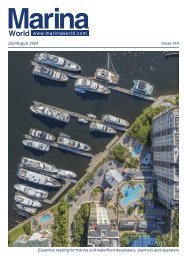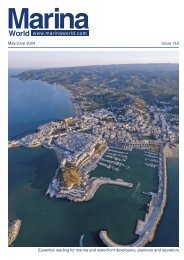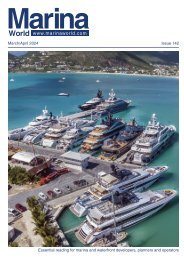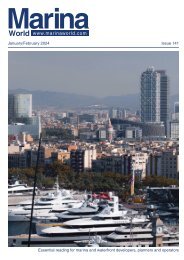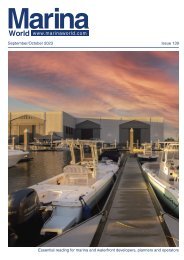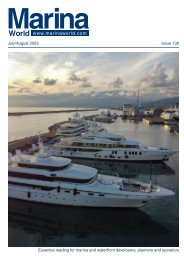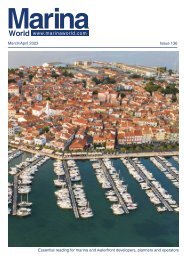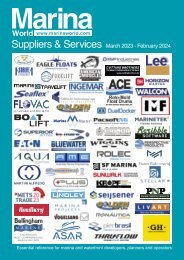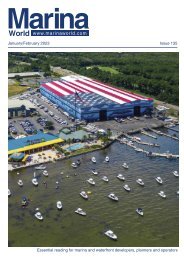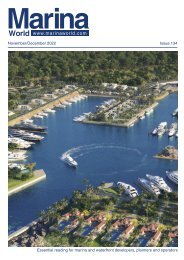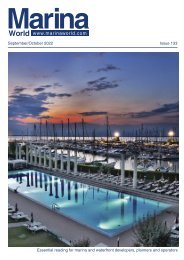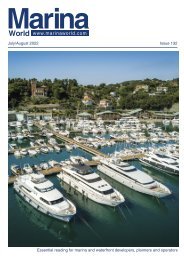2023 May June Marina World
The magazine for the marina industry
The magazine for the marina industry
Create successful ePaper yourself
Turn your PDF publications into a flip-book with our unique Google optimized e-Paper software.
TALKING SHOP<br />
Marine structures, such as this cabin,<br />
remain afloat on Eagle Floats.<br />
used equipment and refurbished<br />
it. Beginning in 2000, we were able<br />
to buy new equipment for all of our<br />
processes. While the capital costs<br />
are high, the efficiency, quality and<br />
capacity are incredibly better than older<br />
technology.<br />
The change in technology is very<br />
rapid in terms of equipment and it is<br />
always occurring. We strive to stay<br />
current. For example, we just added<br />
a completely new computerised<br />
control panel to a 20 year old block<br />
mould. The mechanical parts are<br />
still solid, but with new controls it is<br />
now performing like a completely<br />
different machine. We also build a<br />
lot of our own custom equipment,<br />
including adding programmable<br />
logic controllers to many basic<br />
machines to improve performance<br />
and consistency.<br />
Q: Why do you believe your floats<br />
are the best?<br />
A: Engineering and the use of high<br />
quality equipment and resins. As an<br />
electrical engineer, I understand the<br />
value of quality engineering. We are<br />
the only manufacturer with the ability<br />
to custom build our own tooling. We<br />
also use automated steaming,<br />
dispensing and measuring equipment<br />
that we built and designed in house. We<br />
have done objective testing to verify that<br />
the quality is superior, and the use of<br />
technology and engineering have also<br />
allowed us to be lower priced than the<br />
competition.<br />
Q: While no one can ever guard<br />
completely against freak accidents,<br />
there have been some disturbing<br />
pollution issues with polystyrene<br />
escaping from plastic floats. Is the<br />
quality and/or arrangement of the<br />
polystyrene a risk factor or is it down<br />
to shell impact strength? What types of<br />
quality/strength tests do you undertake<br />
to minimise the risk of pollution?<br />
Hendren Plastics president, Jim Hendren, and vice<br />
president sales, Susie Wallace, proudly display their<br />
latest industry awards from the <strong>Marina</strong> Association of<br />
Texas.<br />
A: We strive hard every day to make<br />
sure that even if a float is punctured<br />
or damaged, the EPS foam core is<br />
fused properly preventing the escape<br />
of beads into the water. We do this<br />
using a proprietary steaming system<br />
that measures the parameters every<br />
50 milliseconds to make sure the<br />
steaming process is correct. If the<br />
foam is fused properly there is almost<br />
no chance of pollution of the water by<br />
loose beads. That also prevents loss of<br />
buoyancy and performance of the float.<br />
Q: Are there any feasible alternatives<br />
to the use of expanded polystyrene for<br />
floating dock systems? Is there any<br />
ongoing R&D in this field?<br />
A: We have tried a couple of<br />
different products, including a resin<br />
called ARCEL that is not prone to<br />
flaking. We have found nothing as<br />
convenient for attaching and as<br />
durable as encapsulated EPS foam<br />
(Eagle Floats). I’m sure research will<br />
continue, but compared to the days<br />
of unencapsulated white foam flaking<br />
off and being destroyed by animals or<br />
abrasion, the encapsulated float is a<br />
huge improvement.<br />
Q: What significant factory expansion<br />
have you undertaken?<br />
A: Since making our first Eagle Float<br />
in 2008, we have invested nearly $7<br />
million in additional equipment and<br />
plant expansion. In the last two<br />
years we have added an additional<br />
15,000ft² (1,400m²) of manufacturing<br />
space and both a new carousel<br />
and shuttle rotational moulding<br />
machines. These were some of the<br />
largest machines in the industry<br />
and nearly doubled our production<br />
capacity. This expansion has cut our<br />
backlog by two thirds and given us<br />
the ability to make even larger parts.<br />
Q: What is your market reach? Do<br />
you have plans to extend this?<br />
A: <strong>World</strong>wide – we are always looking<br />
to expand our reach and increase our<br />
overseas business.<br />
Q: What are the biggest challenges<br />
currently facing manufacturing<br />
companies in the USA?<br />
A: Labour shortages. Last year the<br />
supply chain was a real problem but<br />
it seems to have settled down. Every<br />
other manufacturer I talk to has the<br />
same struggle as we do of finding<br />
sufficient workers to meet the demand.<br />
44 www.marinaworld.com – <strong>May</strong>/<strong>June</strong> <strong>2023</strong>



